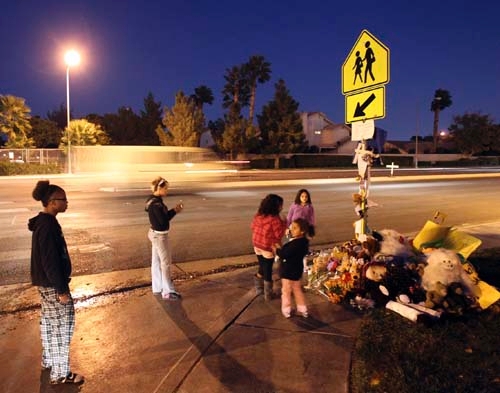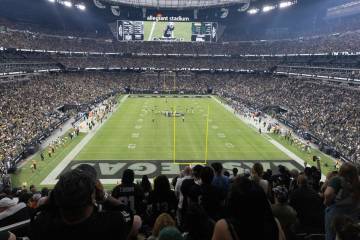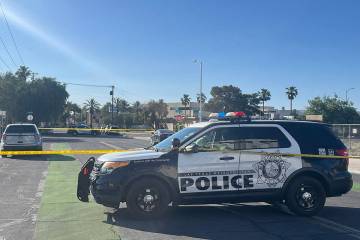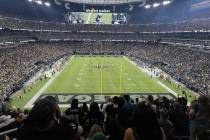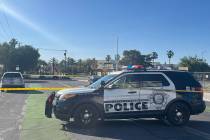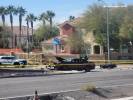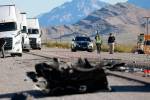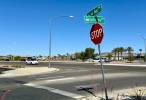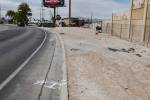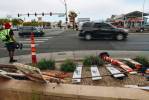Officials lament loss of girl hit by car despite safety project
With the number of pedestrian fatalities in Nevada nearly double the national average, traffic experts became more aggressive in their attempts to improve not only crosswalk markings but the contentious relationship between pedestrians and motorists.
Accidents involving pedestrians is a problem across the Southwest where straight, wide streets often invite motorists to exceed the speed limit and lose focus, said Erin Breen with University of Nevada, Las Vegas' Safe Partnership Community.
"We live in a world where the car is king," Breen said. "An engineer's job is to move traffic, but there has to be a balance somewhere."
North Las Vegas law enforcement officers have been at the forefront of the campaign to strike that balance.
Yet, it is their jurisdiction where a memorial of stuffed animals is now heaped below a pedestrian warning sign. It is within their jurisdiction that handmade signs with words of encouragement are taped on the outer walls of the adjacent neighborhood.
It was in their city where three small children walking in a crosswalk were struck by a 78-year-old woman who failed to yield as three other vehicles had. Six-year-old Amelia "Mia" Decker died from her injuries.
The incident was difficult for the North Las Vegas Police Department, which has invested a lot of time and taxpayer money to protect residents who choose to walk.
The crosswalk that stretches across Camino Eldorado and links Eldorado Park and surrounding neighborhoods is marked with bright yellow, diamond-shaped signs showing children walking. The warnings are the same as the signage in school zones.
Juliet Casey, spokeswoman for the city of North Las Vegas, said engineers recently visited the site and found that the crosswalk met requirements set out by the state. But the city is looking into what, if anything, can be done to improve the crosswalk.
'ONE IS FAR TOO MANY'
Law enforcement agencies throughout the Las Vegas Valley join together several times a year to target problem areas and cite motorists who blow through crosswalks. North Las Vegas is the only city in the valley that applied for grant money to perform additional crosswalk stings and host educational programs.
The department received $60,000 from the Nevada Department of Public Safety to hold pedestrian safety events. Part of the program includes sending undercover officers across the street and nabbing motorists who fail to obey the law.
"They've done everything they possibly can," Breen said.
Since the effort to educate motorists and pedestrians about related laws began about four years ago, North Las Vegas officials saw their pedestrian fatality figures decrease. In 2007, seven fatalities were recorded in the city; in 2008, three pedestrians were killed; in 2009 and 2010 each, there was one. Friday was the first pedestrian fatality in North Las Vegas this year.
"As you can see, one is far too many," North Las Vegas police officer Chrissie Coon said.
The department had never before received complaints about the visibility of the crosswalk where Mia was killed, and Coon noted that other motorists traveling on Camino Eldorado during the time the children were hurt noticed the pedestrians.
"There was something all of these drivers saw that made them stop their vehicles and yield to pedestrians," Coon said. "If the person didn't see the cars stopped, didn't see the children, what else are you going to put up there to make that person stop?"
Police detectives are still investigating the accident, and their focus has been more on the driver who struck the children than the safety of the crosswalk.
Whether the crosswalk markings or the driver are to blame, the accident brought to light the dangers of pedestrians and motorists in the Las Vegas Valley.
Breen said the lack of respect motorists have for pedestrians has led to a more dangerous problem. People walking have learned not to take the time to find a crosswalk because they don't believe motorists will treat them any differently whether they are legally or illegally crossing the street.
"Motorists teach pedestrians to behave badly by not showing them the courtesy of stopping when the pedestrian is doing what they're supposed to do. Motorists ignore them," Breen said.
Many drivers do not seem familiar with the state law that requires them to stop if they see another vehicle has halted at a crosswalk.
FINDING A BALANCE
Between 2005 and 2009 -- the most recent figures published by the state's Strategic Highway Safety Plan -- 258 pedestrians were killed in Nevada. Most of those fatal accidents occurred in the Las Vegas Valley and within marked crossings.
"We need to start thinking not only as engineers but as users. We need to find a balance," Nevada Department of Transportation Director Susan Martinovich recently said while promoting the state's new Zero Fatalities program.
Regional Transportation Commission officials also recognize the need to reconfigure streets so they accommodate both traffic flow and pedestrians.
General Manager Jacob Snow has been advocating "complete streets," which include bicycle lanes and wider, better landscaped sidewalks. The idea is to make some roads more narrow so motorists drive slower and actually make eye contact with those who are not in vehicles.
Mid-block crosswalks cause most concern because drivers do not anticipate seeing pedestrians like they might at a signaled intersection.
"We have these long stretches of road where cars are very comfortable going over the speed limit," Breen said. "They have wide lanes and good sight distances. For pedestrians, there are very few places to cross these streets. When we give pedestrians better access, motorists actually stop for them."
A prime example is Maryland Parkway adjacent to the UNLV campus.
Among other features, the crosswalk has rapidly blinking LED beacons that flash in an irregular pattern.
According to a St. Petersburg, Fla. study, the rate at which drivers yielded to pedestrians jumped from 8 percent to 80 percent at intersections where this type of technology was installed. The signals can be seen 1,000 feet away during daylight.
Breen said the traditional amber flashing lights cost more than $100,000 to install because they must be wired into electric lines below ground. The rapid-flashing signals, which can be activated by pedestrians preparing to cross the street, are solar-powered and cost about $13,000.
"It would be crazy for them (transportation officials) not to look at it," Breen said.
Blinking lights are more effective in capturing drivers' attention, but like motorists who routinely run red lights, there will always be those who ignore crosswalk flashers.
"It's a matter of driving distracted and not giving yourself enough time to get where you are going," she said. "You don't think when you're in a hurry."
Breen encourages pedestrians to peer toward oncoming traffic at each lane marker to be sure all traffic has stopped.
She encourages drivers to always be on the lookout for pedestrians.
"We treat them like second-class citizens," she said of walkers. "On the other side, we're promoting people to get out of their cars and biking or walking. We're talking out of both sides of our mouths."
Contact reporter Adrienne Packer at apacker@review journal.com or 702-387-2904.



